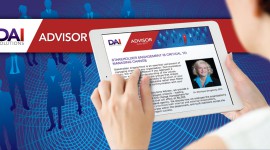02 Mar
2016
COMPETENCY MODELING AND YOU: HOW A WELL-DEVELOPED COMPETENCY MODEL FITS INTO YOUR WORKFORCE PLAN
cnguyen@dai-solutions.com
79
competencies
,
develop
,
employee life cycle
,
evaluate
,
OPM
,
recruit
,
strategic workforce plan
,
transition
,
workforce planning
0 Comments
What will your organization look like in five years? In ten? What knowledge, skills and abilities must each of your employees demonstrate to ensure your organization’s future success? Which employees should lead the charge to that success, and what will it take for them to develop leadership traits?
Having answers to these questions is critical when your organization is planning for the future. Developing a strategic workforce plan—a blueprint of your organization’s future—begins with establishing overarching goals and then working backwards to define a path to success. A strategic workforce plan includes the identification of the skills your workforce will need in order to reach your organization’s goals. These skills are commonly identified as competencies.
 What are competencies?
What are competencies?
According to the Office of Personnel Management (OPM), competencies are measurable patterns of knowledge, skills, abilities, behaviors and other characteristics that an individual needs in order to successfully perform work roles or occupational functions. Competencies specify “how” to perform the unique job tasks that make up each position within your organization. They identify what an employee must do to perform his or her job successfully.
More broadly, a competency model serves as the overarching thread that connects each phase of an employee’s career life cycle within your organization. A valid competency models allow an organization to recruit for specific competencies, or skills, and thus be more successful at selecting and retaining employees—in particular employees who have the proficiencies required to effectively perform the work required at various organization levels.
A valid competency model also allows an organization to develop and evaluate performance—from an employee’s onboarding until he or she transitions out of the organization. Shared and job-specific competencies combine together to form a holistic competency model that includes all of the competencies required for a particular occupation.
In a competency-based organization, employees understand the relationship between their career level and the expectations held of their skills, knowledge and abilities. A competency-based organization has a clear link among career progression, performance, professional development and learning. Managers can easily identify, transfer (or recruit for) the knowledge, skills and abilities lost when an employee resigns or retires from the organization. An organization’s competency model is an overarching thread for the employee and organization alike—successfully designed, it will complement, align with and foster the objectives and goals of your strategic workforce plan.
Taking things a step further, there are two types of competencies required in an occupation: non-technical and technical.
Non-technical competencies are those skills that are applicable to all jobs and positions within the organization. Examples include skills in communication, problem solving, conflict management and teamwork. Non-technical competencies include the ability to actively demonstrate a company’s defined values. While the degree of proficiency displayed may vary by occupation or by position level, all employees are required to demonstrate these competencies and their associated behaviors.
Technical competencies encompass bodies of knowledge, skills and abilities specific to an occupation. Examples include an engineer’s computer coding skills, a contracting specialist’s budgeting expertise, or a learning solution specialist’s ability to develop virtual coursework.
If your agency was a rowboat trying to make its way to a destination, having the right people at the right time and in the right seats on the boat would be critical to getting to the destination on time. The cost of not having the right person in the right seat on the boat is quite high.
According to a Society for Human Resources Management (SHRM) 2008 article, research suggests that the cost to replace an employee (called a direct replacement cost) can be as high as 60 percent of an employee’s annual salary, with total costs associated with a turnover ranging from 90 percent to 200 percent of annual salary. Maximizing your organization’s ability to select the right person the first time around is extremely important to your organization’s economic health and to the accomplishment of your organization’s mission and goals.
Competencies can be changed and refined as an organization adapts to shifting hiring or industry environments, but by understanding the basics of competency modeling an organization maximizes its chances to attract, recruit and hire the right person in the right position at the right time.
Want to talk to a DAI workforce planning expert? Contact us today to get started: bd@dai-solutions.com. Don’t forget to follow us on Facebook, LinkedIn and Twitter.





